The XV PATRICK BLACKETT was officially certified at 10:09 this morning, and by 11:01, the vessel was already underway.
The successful certification and deployment of XV PATRICK BLACKETT demonstrates NavyX’s commitment to developing autonomous and unmanned technology, which will revolutionise naval operations in the future.
Certified at 10:09, underway at 11:01. Today marks XV PATRICK BLACKETT’s first outing under the blue ensign and the start of the next phase for this project. It’s been challenging, but NavyX has achieved something many said was unachievable. #NavyX #PTBK. pic.twitter.com/rstfBm7RcY
— NavyX (@RNNavyX) February 20, 2023
XV Patrick Blackett (X01) is a groundbreaking experimental ship employed by the Royal Navy to serve as a testing platform for cutting-edge technologies, including unmanned underwater vehicles and unmanned surface vehicles. The vessel’s namesake, Patrick Blackett, was a renowned British physicist who served in the Royal Navy and was a recipient of the Nobel Prize.
Patrick Blackett is a modified Fast Crew Supplier 4008 (FCS 4008) designed and constructed by Damen Group. It features a unique matte black finish, as opposed to the customary grey of the Royal Navy, and bears the NavyX emblem on both sides of its hull. Its pennant, X01, is prominently highlighted with gloss paint, while large QR codes on the superstructure allow smartphone users to access NavyX content.


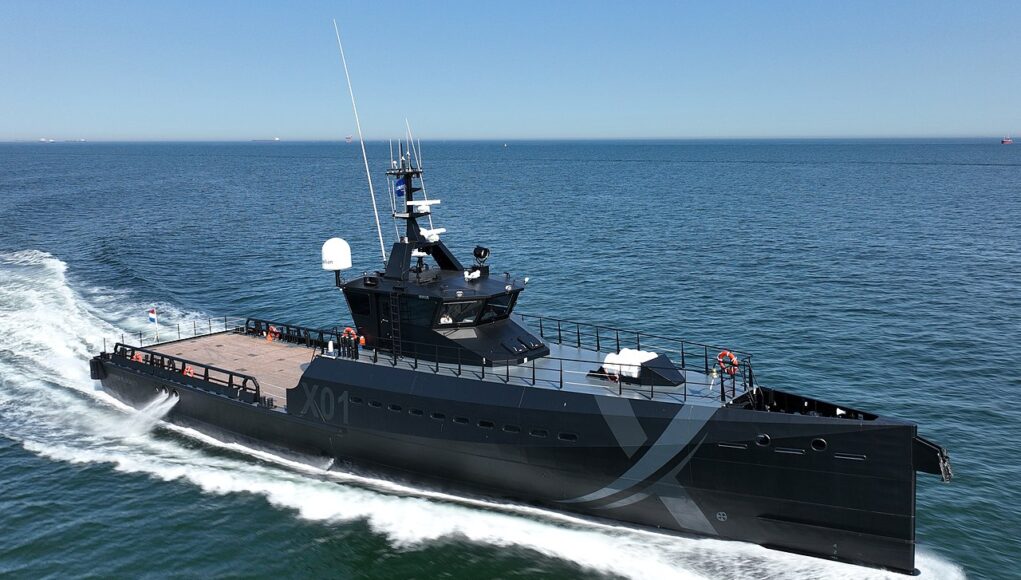
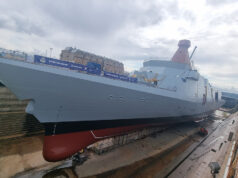


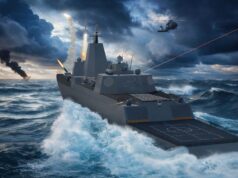
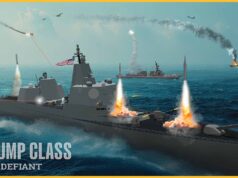
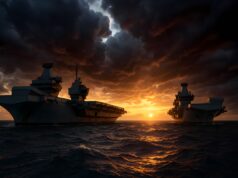
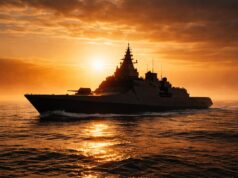

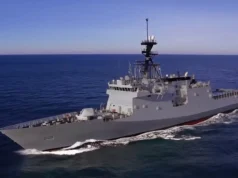

Whats the Bobby Moore, regards this trend for a less angled Bow?
I asked that a while back when Bae showed their inverted bow T-32 frigate proposal, others are going the same way I note. Must admit I didn’t check back to see any explanation but I did check out a site that went through the various bow shapes and their supposed plus minus points. Trouble is it didn’t really clearly demonstrate any real advantages for a non traditional bow which is superior in preventing the bow from diving and in maintaining a consistent course by the way it parts the water. But clearly there are reasons for going inverted or just vertical as in this case. I presume a smaller vessel with less speed and unlikely to be making serious headway in heavy seas might be advantageous in terms of capacity perhaps but can’t think of any other reason offhand. Someone here must be an expert.
The general principle with wave piercing designs like this (and others prevalent in offshore oil/gas industry support vessels) it that the ship cuts through rather than rides over oncoming waves, reducing ship motion in a seaway, which is more energy efficient and more comfortable. Hopefully less broken crockery too😀
Trevor wrote:
Funny you should mention that, I was sent this last week:
https://i.postimg.cc/Jn4w1nC4/image-2023-02-20-192951474.png
Utterly, utterly disgraceful, where are we going when stupid people who are unable to sit in a chair properly have bump and saa a chance to fill their greedy boots for their own misadventures, I hop she is binned from the service, she’s UTTERLY pathetic.
There’s an article doing the rounds about the USS Zumwalt, which has a very pronounced inverted bow. It also has a strange hammerhead like shape just below the water line. Apparently it’s stealthier, but also very stable in storm conditions.
Racing yachts use this; apparently it helps wave piercing.
Bit like a brick I suppose 😂
Not sure: but my guess is that the structure beneath the waterline, is more important than above the waterline. The negative bow angle on the Zumwalt for instance, could be part of the stealth characteristics. Need a marine engineer.
Speed the longer the hull length at the water line the faster the ship….the downside is a lowered centre of buoyancy which means a less stable ship.
also a raked bow can act as a bumper..in that you smash the rake bow before doing damage at the waterline….a zumwalt is going to do Damage at the waterline or below the waterline first.
The inverted bow seems to have a better attitude in the waves.
That’s what I read about the FDI, with the same design.
Getting the right prow on a ship goes a long way to negating the need to have mechanical stabilisers on the hull itself if you look at the bows of many earlier ships of Ww1, you’ll see pointy ends of numerous shapes an earlier post mentioned cutting through the seas rather than riding on i.it anyone who has spent any time in a flat bottomed boat in a choppy body of water will not have enjoyed it. Sailors on the flowers corvettes inWW2 oft mentioned that the ships movement was extremely uncomfortabl, and unhealthy give me a raked bow anytime
Axe bow is claimed to cut through waves and reduce pitching. Looks like some early ironclads.
It’s called a plumb bow it’s actually just about the oldest design of bow. as it does not have any rake it maximises the length of the waterline so increasing speed. A raked bow ( the one we see on most modern ships) with or without a bulb reduces the waterline length of the ship so making it a touch slower.but it raises the centre of buoyancy and so increases the ships GM ( stability). Which is good.
So the plumb bow on the Patrick will increase is speed but reduce its GM and impact on its meta centre, this increases the chance of a tender vessel, which is essentially to much weight up high for the hull form, this means that it is slower to come out of a roll and has a greater chance of capsizing.
Also if you have a plumb bow you cannot have handy flare…flare is important for keeping a dry ship in heavy seas states.
At 15/16 seconds the video shows a distinct ‘cleft’, maybe a foot wide, from the the top of the bow down at least to the waterline. Is this design feature something meaningful?
Anchor run.
It worked for the Greeks 2000 years ago we’ve gone full circle in design Johnathan
Does this mean that steam and sails, and wood will get a comeback?
To return too those of Men of Steel with hearts of Oak , days not very DEI alas Andy
i loved steam boiler rooms with roaring fans, temperatures over a hundred degrees washing dry in ten minutes,great days gass turbines? diesels? no thanks.
Pot mess boiling away for the Lads during the middle watch STR boys didn’t need a sauna it was a sauna
Hope this explanation helps Farouk!
Types of Bow Designs Used For Ships
LINK
Missing the Italian PPA bow.
Best supply it to Farouk in that case 🙄
Thanks, Nigel.
👍
Any ideas why certification was challenging? Assuming that’s what the tweet is saying.
Hi John,
It is a very different craft to the vessels the RN normally uses and its mission is also unusual, as such the navy has probably had to write the manual for this process. Obviously, there will be a lot of standard stuff but anything associated with the experimentation they are looking to undertake would need to be written from scratch. There are contractors who might be able to help, QinetiQ had Triton in service a few years ago but this type of craft is quite unusual I think.
Cheers CR
Thanks CR, I thought there’d be a sensible explanation. I’ve seen a bit of criticism about this vessel being out of action since delivery.
Was it? I didn’t read that from the article. It was about how quickly the ship got underway after certification.
Purchased in March 2022 as a civvy supply ship and converted to a novel experimental role trialling unmanned technologies, I think to certify for unmanned use and commission the vessel in less than a year is remarkable.
That’s the way I read the NavyX tweet above but may well have got the wrong end of the stick.
I agree this project is progressing exceptionally well. CR’s post above does highlight some of the difficulties that may have been faced.
You can be sure the marine engineers / architects have designef the hull to be sea worthy & meet the Navys requirements of operations!
Quite a few yrs ago the ‘plumb’ bow as someone commented it was called became the vogue in private sailing yachts which I asked a friend about it. My boat at the time was tradition raked bow.
My friend knew people in the marine business in the design field & worked in a boatyard most of his life. He told me the reason for the plumb bow in private yachts was to reduce the wasted space of the overhang as well as cost.
On a smaller private vessel the bow area, which mainly housed the anchor chain/ warp could leave a redundant or impractical area of the yacht. The plumb bow utilised space better & reduced birthing costs in marinas for the private owner. Shortening the yacht by a metre or 3ft could save money when you pay for a birth by the metre & you didn’t loose any speed as the waterline length would still be the same as if you had the extra length in overhang.
I think also the clue is in the name – it’s designed as ‘Fast’ Crew Supplier & therefore designed to go fast. Displacement can be countered by various factors such as beam & ballast & load carrying capabilities.
Tallships were unable to leave port without a cargo or else it would capsize in a sea The cargo it carried acted as the ballast.
Not sure what they categorise as’fast’ in this instance. I was bringing a 60ft ex survey vessel round the coast when I spotted a warship, so I thought on the horizon which then dissappeared! Within half an hour, could have been longer, we were borded by 3 armed men carrying machine guns & pistols off a RIB. They checked our I.D. & I said I saw them on horizon & lost sight of them & how fast was their ship.
They said the Border Force Ship was capable of 35knts or possibly more & needed to be to imtercept – they dissappeared over the horizon & circled around out of our sight & when within range deployed the RIB. That was 6 yrs ago or so, so I expect this new ship is pretty fast!
Responding to Paul: X01 was a fast crew supply ship speculatively built by Daman Group in 2021 in order to avoid a temporary closure of their Gorinchem shipyard in the Netherlands due to a lack of orders. Purchased by the UK’s MOD in March 2022, she indeed arrived in Portsmouth on her delivery voyage flying a Dutch flag. Two days later, on 29 July 2022, she formally joined the RFA and raised the Blue Ensign for the first time.
Here’s to the future.
Drones of whatever ilk will add a lot of capability to the RN , fundementally changing the way it operates. Be it aircraft such as the one going on Lancaster, MCMV Workboats or units to go on T26/31/32 or any other RN unit for that matter
The RNs 11m workboat has a lot of potential for becoming the standard host platform of applications and not just the current MCMV work.
ASW has already been trialled and further capabilities are in the offing.
ARCIMS SeaSense: An Autonomous Anti-Submarine Warfare Solution – Naval News
Maybe this will be able to protect the lame duck HMS carriers.
After the Ukrainian drone boT attack on the Russians warship, I think what we are the first glimpses into the future of naval warfare the royal navys Patrick Blackett could evolve into the warship of the future it might be that soon we’ll be complaining about not enough warship drones instead of actual ships!